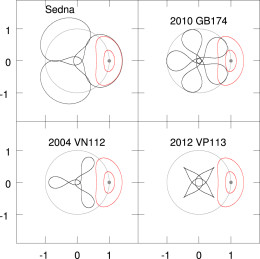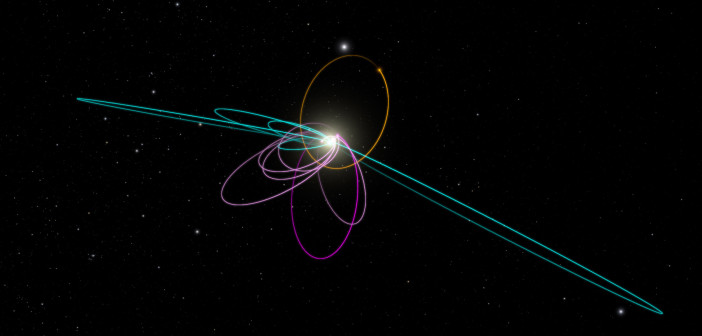What’s the news coming from the research world on the search for Planet Nine? Read on for an update from a few of the latest studies.

Artist’s illustration of Planet Nine, a hypothesized Neptune-sized planet orbiting in the distant reaches of our solar system. [Caltech/Robert Hurt]
What is Planet Nine?
In January of this year, Caltech researchers Konstantin Batygin and Mike Brown presented evidence of a distant ninth planet in our solar system. They predicted this planet to be of a mass and volume consistent with a super-Earth, orbiting on a highly eccentric path with a period of tens of thousands of years.
Since Batygin and Brown’s prediction, scientists have been hunting for further signs of Planet Nine. Though we haven’t yet discovered an object matching its description, we have come up with new strategies for finding it, we set some constraints on where it might be, and we made some interesting theoretical predictions about its properties.

Visualizations of the resonant orbits of the four longest-period Kuiper belt objects, depicted in a frame rotating with the mean angular velocity of Planet Nine. Planet Nine’s position is on the right (with the trace of possible eccentric orbits e=0.17 and e=0.4 indicated in red). [Malhotra et al 2016]
Resonant Orbits
Renu Malhotra (University of Arizona’s Lunar and Planetary Laboratory) and collaborators present further evidence of the shaping of solar system orbits by the hypothetical Planet Nine. The authors point out that the four longest-period Kuiper belt objects (KBOs) have orbital periods close to integer ratios with each other. Could it be that these outer KBOs have become locked into resonant orbits with a distant, massive body?
The authors find that a distant planet orbiting with a period of ~17,117 years and a semimajor axis ~665 AU would have N/1 and N/2 period ratios with these four objects. If this is correct, it significantly constrains the parameters of Planet Nine’s orbit — as well as where it currently could be within its orbit.
Eliminating Hiding Spots
Brown and Batygin have returned, this time with more detailed estimates of Planet Nine’s potential orbit and location. By performing an enormous suite of simulations and then comparing the outcomes to actual observations of the distribution of KBOs, the authors narrow the allowed range for Planet Nine’s orbital characteristics.

Authors’ predictions for the location, distance, brightness, and speed of Planet Nine throughout its orbit. Colored regions have been or will be explored by previous or current surveys capable of detecting the planet. Black regions remain places where Planet Nine could lurk. [Brown & Batygin 2016]
Planet Nine’s Atmosphere
Finally, Jonathan Fortney (UC Santa Cruz) and collaborators model Planet Nine’s atmosphere. Rather than assuming the planet behaves like a blackbody, they use the planet’s predicted orbit — as well as a range of plausible masses and interior structures — in models that treat the body like the giant planets of our solar system.
The authors find Planet Nine is likely quite cold, as expected, with an effective temperature of ~35–50 K at most (for reference, Neptune is around 60 K). Because of this cool temperature, the authors speculate that methane may condense out of the atmosphere, changing the planet’s reflection and emission spectra. This would cause the planet to appear much “bluer” than planets like Uranus and Neptune in infrared energy bands.
The constraints from these studies continue to support the existence of Planet Nine, narrow down the regions in which we should search for it, and help us to better understand what signatures we’re looking for. In the words of Fortney et al., “Let the hunt continue.”
Citation
Renu Malhotra et al 2016 ApJ 824 L22. doi:10.3847/2041-8205/824/2/L22
Michael E. Brown and Konstantin Batygin 2016 ApJ 824 L23. doi:10.3847/2041-8205/824/2/L23
Jonathan J. Fortney et al 2016 ApJ 824 L25. doi:10.3847/2041-8205/824/2/L25


7 Comments
Pingback: narrowing the search for the KB planet (9 or 10, depending....)
Pingback: An Update on Planet Nine | Historia y noticias ...
Pingback: 48th DPS/11th EPSC Meeting: Day 3 | astrobites
Pingback: 48th DPS/11th EPSC Meeting: Day 3
Pingback: Allgemeines Live-Blog ab dem 6. Januar 2017 | Skyweek Zwei Punkt Null
Pingback: Update on an Interstellar Asteroid
Pingback: Looking Back at 500 AAS Nova Highlights